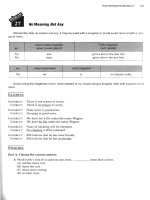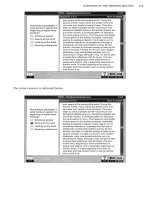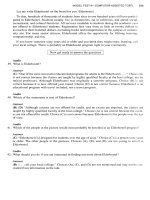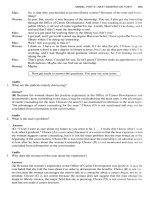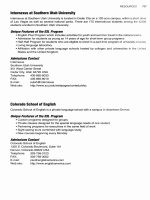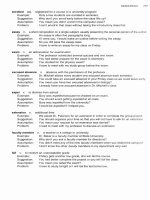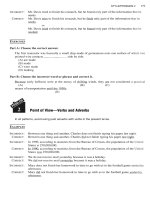How to Be a Successful Life Coach: A Guide to Setting Up a Profitable Coaching Business docx
Bạn đang xem bản rút gọn của tài liệu. Xem và tải ngay bản đầy đủ của tài liệu tại đây (972.09 KB, 240 trang )
Ifyouwanttoknowhow
Learning to Counsel
Develop the skills, insight and knowledge to counsel others
Learning to Coach
For personal and professional development
Free Yourself from Anxiety
A self-help guide to overcoming anxiety disorders
365 Ways to be Your Own L ife Coach
365 Steps to Self-Confidence
howtobooks
Send for a free copy of the latest catalogue to:
How To Books
Spring Hill House, Spring Hill Road , Begbroke
Oxford OX5 1RX. United Kingdom.
email:
www.howtobooks.co.uk
howtobooks
Published by How To Content,
A division of How To Books Ltd,
Spring Hill House, Spring Hill Road,
Begbroke, Oxford OX5 1RX. United Kingdom.
Tel: (01865) 375794. Fax: (01865) 379162.
www.howtobooks.co.uk
How To Books greatly reduce the carbon footprint of their books by sourcing their
typesetting and printing in the UK.
All rights reserved. No part of this work may be reproduced or stored in an information
retrieval system (other than for purposes of review) without the express permission of the
publisher in writing.
The right of Shelagh Young to be identified as author of this work has been asserted by
her in accordance with the Copyright, Designs and Patents Act 1988.
© 2009 Shelagh Young
First published in electronic form 2009
British Library Cataloguing in Publication Data
A catalogue record for this book is available from the British Library
ISBN 978 1 84803 310 8
Cover design by Baseline Arts Ltd, Oxford
Produced for How To Books by Deer Park Productions, Tavistock, Devon
Typeset by PDQ Typesetting, Newcastle-under-Lyme, Staffs.
NOTE: The material contained in this book is set out in good faith for general guidance
and no liability can be accepted for loss or expense incurred as a result of relying in
particular circumstances on statements made in the book. Laws and regulations are
complex and liable to change, and readers should check the current position with the
relevant authorities before making personal arrangements.
Contents
1 What is Coaching? 1
Creating your ‘elevator pitch’ 2
Helping people find out what they want to do 5
Top four coaching principles 6
Relationship building 6
What coaching is not 10
What coaching entails 12
2 Developing Your Coaching Skills 14
Are you a successful coach? 15
Developing your coaching skills 19
What do clients look for in a coach? 28
Working as a volunteer 33
Is membership of a professional body essential? 35
3 My Dream Business 45
A business that fits your life goals 45
Planning: first steps 47
Challenging/satisfying work 52
Respect 53
Opportunity to grow my income 54
Opportunity to become an employer 55
Creating a vision for your coaching business 56
Growing your business 60
Whatisitallfor? 63
4 WhoDoYouWanttoCoach? 65
What are these special interest areas? 66
5 Choosing the Right Client Market 79
People like people like themselves 82
The great divide: corporate vs personal 85
v
6 How Will You Deliver Your Coaching? 90
Thinking about your modes of coaching 91
Face-to-face coaching 91
Telephone coaching 96
7 Form Follows Function – Designing Your
Business Structure 105
Becoming a sole trader 107
Forming a partnership 110
Becoming a limited company 112
Creating a co-operative 114
Social enterprises and not-for-profit businesses 118
Could I start a charity? 121
What is a voluntary sector organisation? 122
Clearning the final hurdles 123
8 Marketing Your Business 124
Building trust 126
What is marketing? 127
What is a marketing strategy? 128
How to write a marketing strategy and plan 130
Are websites useful? 146
Final thoughts 147
9 Growing Your Business 149
Moving from part-time to full-time coaching 150
Partnership working 152
Sub-contracting 153
Becoming an employer 155
Successful tendering 161
10 TheEthicalCoach–ProtectingYouand
Your Clients 164
What are the risks of not abiding by clear ethical
standards? 165
What are the most important ethical issues? 166
Setting a coaching code of conduct 184
Client codes of conduct 185
Handling risk 188
Insurance 188
Health and safety 189
vi Contents
Harassment 190
Maintaining your own mental health 191
11 Writing Your Business Plan 195
What a business plan tells the world 196
Mixing the ingredients of your business plan 201
A step-by-step guide to writing the plan 202
12 The Beginning is Not the End 221
Continuing professional development 222
And finally. . . 226
Useful resources 227
Index 229
Contents vii
This page intentionally left blank
1
What is Coaching?
If you have already studied to become a coach you already know
the answer to this question. If you think you know exactly what
coaching is then you can afford to skip a few pages to Chapter 2
and start thinking about how to develop your coaching skills to the
point at which you can run a successful coaching business. If you
have any doubts whatsoever then read on. Knowing exactly what
we mean by ‘coaching’ is not always as simple as it seems.
At the most basic level coaching is a conversation. Only it isn’t the
kind of conversation most of us would want to have with our
friends when we are out to ha ve fun. For a start, an effective
coaching session should be hard work for both the coach and their
client. The client has to do a lot of thinking and talking. The coach
has to do a lot of thinking and listening. Both have to be 100 per
cent focused on the coaching session and 100 per cent committed
to bringing it to a successful conclusion. If they are not, then the
session will not deliver the best possible results.
None of this is captured by the dictionary definition of coaching.
Almost anyone with adequate knowledge of a subject can do what
the Concise Oxford Dictionary defines as coaching, which is to:
tutor, train, give hints to, prime with facts
This definition barely skims the surface of what you will do in
1
your new business. To be successful in coaching you will need to
build a good quality relationship with every client. This is because
coaching works by encouraging and enabling the client to take
responsibility for their learning and achievements. There is very
little teaching involved in a coaching. The process of coaching is
designed to help people to learn by drawing on their own
resources and resources they set out to find. It is not about spoon-
feeding clients with facts or a great deal of information. This is
why conversations which form the basis of all coaching work must
be quite one-sided. It is the coach’s job to listen and reflect back
k ey points to the client in order to help them focus on how they
will bring about change. A coach who says too much is unlikely to
be meeting the client’s needs.
Coaching is still not widely understood. Most of us want
information and advice to help us change our lives. Lots of your
clients will try to extract information and advice from you. Don’t
let them succeed. You are not an expert advisor. You are a coach. If
your prospective clients do not understand what it is that you
have to offer then mak e sure you have a short, clear way of letting
them know.
CREATING YOUR ‘ELEVATOR PITCH’
Take a moment to think about what you will say when someone
asks you what you do or what working with a coach will be like. In
the film and television business people talk about having an
elevator pitch ready. An elevator pitch is just a short, sharp,
motivating and engaging summary of their TV or film idea. It is
for those moments, such as when you share a lift, when you meet
someone you want to influence. You can’t risk boring them and
they are too busy to make an appointment to see you. So you
2 Chapter 1
.
What is Coaching?
briskly pitch your idea whenever you get the chance. A successful
coach needs to be able to do this too.
What will your elevator pitch be? Try writing down some options.
Then say them out loud. Do they roll off the tongue easily? Try
them out with an honest friend or family member. Do they get
your meaning? Are they excited by the idea of coaching? The
opportunity to pitch for coaching business is there every time
someone asks you what you do, so your first attempt should work
as an answer to the typical question: ‘What do you do?’
This elevator pitch is really important because an excellent coach
leads a process that differs quite a lot from the general common
sense understanding of what coaching entails. This is possibly
because the first ideas that come to mind when most of us think
about ‘coaching’ are examples from sport. The sports coach is the
most well-known example of a coach in action. When we think
My elevator pitch
I’m a coach actually.
I
Here’s my card. Call me when I can help you.
Chapter 1
.
What is Coaching? 3
about sports and what a team or individual sports coach does we
often imagine someone who tells the athletes or players what to
do and how to do it. For example, explaining or demonstrating
better techniques for running, instructing in the art of the
successful tackle or telling athletes what to eat to stay in peak
fitness.
We can visualise the coach shouting advice from the sidelines or
holding a stopwatch and timing training runs. The coach will
probably pat the sportsperson on the back when they have done
well and give them a pep talk when they haven’t achieved a
hoped-for result or a personal best. We don’t tend to imagine the
athlete saying much when the coach is on the scene. In this
scenario we invest the coach with the expertise, knowledge,
solutions and authority and the athletes just do what is asked of
them.
Luckily, this is not how the best sports coaches work and it is
certainly not the best way for you to help anyone achieve their
personal best. Of course it is possible to assist people to learn new
technical skills by showing and telling. For example, an athlete
aiming to win a hurdles race will need to learn the best-known
way of running such a race. However, the limitations of this
approach have been proved time and again. In high jump
competitions everyone used to jump by running and executing
a scissors-style jump which straddled the bar. They were jumping
as they had been told to do. Now nobody jumps this way because
someone came up with a better idea.
In 1968, Dick Fosbury decided to try a different style of jump
which he believed would enable him to clear greater heights. Dick
Fosbury invented the Fosbury Flop, a technically more efficient
4 Chapter 1
.
What is Coaching?
means of jumping which enables athletes to use their body weight
to help their feet clear the bar. Presumably it took quite a lot of
guts to run up to a bar and throw himself over it backwards when
everyone was doing it different ly (especially before spe cial
padded landing areas were introduced once his idea caught on),
and this is exactly why coaching is also about supporting clients.
Our clients are often trying to do something new, different and
challenging. Everyone needs support when they decide to push
themselves to achieve more or achieve things differently. Trying
new things isn’t easy, and even with the laws of physics on his
side Dick Fosbury probably had his moments of doubt. The point
is he wanted to jump higher. This was his goal and he work ed out
a means by which he felt he could achieve that goal.
HELPING PEOPLE FIND OUT WHAT THEY WANT TO DO
Helping people find out what they want to do and how they are
going to do it is the essence of coaching. So if someone asks you
what you do as a coach try telling them this: ‘I help you find out
what you really want to do. Then I help you work out how you
will do it and when.’
The ‘when’ is the golden key in coaching. It is only when the
majority of your coaching sessions end with your clients knowing
what they want, what they will do to get it, how they will do it
and when they will do it, that you can ever really claim to be
coaching successfully. And never forget that real success is defined
by goals achieved. Good intentions are the starting point not the
end point of effective coaching.
Chapter 1
.
What is Coaching? 5
TOP FOUR COACHING RULES
Coaching successfully is a thrilling, engaging occupation. It is also
highly challenging because so much of the success of every
coaching session depends on you. You cannot achieve goals for
your client but by abiding by some clear coaching principles you
can ensure that you maximise your client’s ability to set and
achieve ambitious goals as a result of your coaching. For your
coaching to be successful you must be working with a client who
has the will to make change happen. Your job is to inspire them
and help them find the motivation to take the first step and follow
through to the end.
There are four key principles which must always inform your
behaviour as a coach. As a coach you should always:
1 Build your coaching relationships on the basis of honesty,
openness and trust.
2 Accept that your client is responsible for the results they
achieve.
3 Always focus on the client.
4 Always believe in your client’s ability to achieve more and
better results.
The skilled coach makes putting these principles into action look
easy but it is challenging work. If you hold to these four principles
you will create a sound basis for effective coaching.
RELATIONSHIP BUILDING
When your clients trust you enough to open up and begin to
6 Chapter 1
.
What is Coaching?
share their innermost thoughts, their dreams and their night-
mares you ha ve the raw mat erial for making your coaching work
effectively. Clients will always open up to you if they firmly
believe that you are listening to them and have their best interests
at heart. The trick is to make this happen quickly. Clients want to
feel they are moving forward. You do not have the luxury of
lengthy sessions for building trust. Clients want progress from the
very first session. And why not?
So, you can build relationships quickly by sticking to the very
basics of coaching.
&
Never dominate the coaching conversation. Let your clients do
most of the talking at every stage of your interaction. This is
where your elevator pitch comes in handy too. You need to
explain what you do very quickly to allow space for clients to
talk.
&
Don’t play the expert. It is often useful if you ‘g ive hints’ and
coaches may well ‘prime with facts’, as suggested by the
dictionary definition of coaching. However, it is not your job to
dominate the conversation or assume the expert role in the
relationship.
&
Show quickly that you trust your clients to find the best
solutions for them. Trusting your client includes trusting them
to set their own challenges and find their own solutions. Start
by responding to their concerns with a phrase that lets them
know you believe in their ability to make changes happen.
Sounds hard? Look at the examples in the box. How hard can
it be to come up with your own phrases along these lines?
Chapter 1
.
What is Coaching? 7
Every time you show you trust your client you will boost their
confidence. Confident people find it a whole lot easier to place
their trust in others.
Remember, the importance of trust in the coaching relationship
applies to every party. If you do not trust a client, particularly
when this lack of trust takes the form of doubting the client’s
ability to succeed in their chosen field, you should not work with
that client. Coaching is based on the belief that goals are most
likely to be achieved when the clients set them for themselves and
work out their own ways of achieving them. If you are cynical
about a client’s ability you have no useful role to play in this
process and almost certainly risk undermining your client.
You will limit your client’s achievements if you hold limiting
beliefs about them and their abilities. However good you are at
covering your true feeling they are likely to leak out during your
contact with a client and ha ve a negative impact on your client. If
you do not believe in your client’s ability then your client will pick
up negative signals from you either consciously or unconsciously.
This will undermine trust. A client who does not trust you is
unlikely to achieve their full potential with you as their coach.
‘You probably know what would be best in this situation. Tell
me what you’ve been thinking so far.’
‘It sounds as if you know what to do. Tell me what you want
to do next.’
‘You’ve obviously thought about this a lot. What would make
it easier to reach a decision?’
‘I’m impressed by your insights. When will you make a
decision?’
‘You’ve obviously worked hard on developing these skills/ideas/
options. Tell me what your next step will be.’
8 Chapter 1
.
What is Coaching?
Coaching is about removing limiting beliefs and keeping the client
convinced of his/her ability to make positive change happen.
What are limiting beliefs?
A limiting belief is an untested idea about yourself which
prevents you from taking certain actions or believing in certain
possibilities.
If you believe you cannot learn to drive you are unlikely to take
lessons. If you take a driving lesson and do not do very well
you have not tested your belief. To test the belief you would
have to stick at driving l essons for quite some time. You would
need some objective proof of your assumed inability.
If you believe you are too ugly to find a lover you might think
you have pro ved the fact because you don’t have a special
person in your life. What you have probably proved is that
people who don’t socialise a lot, ask people out or try Internet
and other dating services have fewer dates, fewer lovers and
fewer successful sexual relationships than people who do all
these things.
Limiting beliefs stop you from making change s in your life
because you don’t see the point. They:
&
undermine confidence
&
stop you from acting to change your situation
&
make you unhappy
&
affect the way other people relate to you
&
keep a vicious circle going in which not trying leads to not
succeeding which is interpreted, wrongly, as objective proof
of inability.
Chapter 1
.
What is Coaching? 9
WHAT COACHING IS NOT
&
Coaching is not therapy.
&
Coaching is not counselling.
&
Coaching is not advice-giving.
Many people would describe their experience of being coached as
highly therapeutic. What they might mean by this is that the
coaching has helped them to satisfactorily address what they
perceive to be problems in their lives. They might mean that
coaching has helped them to feel happier or less st ressed. They
might even mean that coaching has led them to feel healthier and
more energised than they felt at the start of the coaching process.
All of these things can fall from coaching. There is absolutely no
doubt that coaching can help improve a person’s physical and
mental well-being. BUT COACHING IS NOT A FORM OF
THERAPY.
Understanding the difference between
coaching and counselling
So what’s the difference between coaching and counselling or
other forms of therapeutic intervention? Some counsellors would
argue that the difference between coaching and some forms of
therapy and counselling is too slight to be defined. Some coaches
would also say that there ar e so many different forms of
counselling and therapy, and that some resemble coaching so
closely that it is meaningless to try to define the ‘difference’
between them.
There is no real need to strive to define the difference between
coaching and counselling and therapy, but it is really helpful if
10 Chapter 1
.
What is Coaching?
you remain clear about what coaching is and what it entails.
Coaching makes demands on your clients and you have to work
only with those clients who are sufficiently robust to respond to
those demands. You cannot tailor your coaching to make it mor e
like counselling. It is what it is and should not be watered down
when you suspect a client is not coping with life very well. Use
your listening skills to work out what is going on for a client and
help them set goals they can achieve at this stage of their lives.
Coaching and mental health
It would be absolutely wrong to insist that anyone with any
form of men tal illness was unsuited to coaching either as a
coach or a client. Depression is a mental illness, a very
common one which most people experience at least once in
their lives. At the same time it is unfair to engage with a client
who you believe to be too vulnerable or distressed to benefit
from coaching and unethical to pretend that coaching is an
adequate means of addressing serious mental ill health.
You should NEVER work with clients who manifest obvious
signs of serious mental ill health without ensuring they are
being adequately supported and/or treated by others. Even if
you suspect that a very mild form of depression might be
leading your client to be unhappy or to fail to achieve goals,
you should encourage them to seek appropriate professional
help. You should give serious consideration to suspending your
coaching until they are feeling better or getting the additi onal
help they nee d elsewhere.
There is more information on this important topic in Chapter
10.
Chapter 1
.
What is Coaching? 11
WHAT COACHING ENTAILS
Before starting work with any client you should be clear about the
following.
&
Coaching focuses on results and outcomes
The coaching session might be described by the client as
having cheered them up or made them feel better but the
session is never an end in itself. Every session should result in
goals having been set by the client.
&
Coaching focuses on the future
The client might want to explore why they behave as they do
but the coach should always push for action rather than
diagnosis. The objective of every session is to move through
reflection (if this is useful for the client) and towards action.
Coaching is about what a client will do rather than why they
haven’t done it yet.
&
Coaching requires the coach to believe in the client’s capacity
to achieve
There are no conditions which are exceptions to this rule. The
only variables are when and how. There are no ‘ifs’ in
coaching.
&
Coaching will be terminated if the coach is confident that the
client does not have the will to change
This should always be done with sensitivity and include
referral to a more appropriat e service if the coach believes the
client needs help.
&
Coaching will not continue if the coach suspects there are
serious mental health issues affecting the client and which
12 Chapter 1
.
What is Coaching?
are not being addressed by other means
This is vital. Successful coaching requir es a degree of
toughness and insistence on achievement that could be
damaging to a person made particularly vulner able as a
result of problems with mental health. However, it would be
discriminatory to suggest that coaching is never appropriate
for people with a recognised mental health problem. Many
people who are accessing appropriate support for their
particular i llness could also benefit from good quality
coaching.
Now you know what coaching is at its best you need to work on
your coaching offer. In Chapter 2 you will have a chance to assess
your own coaching skills, work out how to keep on developing as
a coach and start thinking about how to keep your skills constantly
updat ed.
Chapter 1
.
What is Coaching? 13
2
Developing your
coaching skills
This chapter will look at how you can develop your coaching skills
both in formal t r aining and in practice. Coaching is an
increasingly competitive field. Your success in running a profit-
able, satisfying coaching practice will largely rest on three things:
1 Good results which generate word of mouth referrals.
2 Successful networking – making contacts which generate
opportunities and referrals.
3 Keeping up to date with industry r equirements.
However, qualifications and membership of professional organisa-
tions will soon start to be an important factor in gaining work.
There are an increasing number of organisations employing
people in roles which are all or partly about utilising coaching
skills. Shortlisting applicants for exciting, well-paid jobs and
deciding between competing bids for contracts is al l about
excluding people to achieve a manageable interview load. It is
clear that employers and people seeking high quality bids for
tenders (i.e. those looking for coaches to work on contract to
deliver specific projects or objectives) or high-achieving staff for
in-house coaching roles will soon, if not already, be forced to set
the bar high to mak e their search manageable.
14
Before we look at the options in terms of training and
accreditation, we will look at the personal side of putting yourself
in the position of being a successful coach.
ARE YOU A SUCCESSFUL COACH?
I hope you said ‘yes’. It does not matter how experienced or
inexperienced you are at this stage of your career. You have to
believe in your skills so that others believe in you too.
Have you ever been coached? If not by a personal coach then
perhaps you worked with a coach in sport or a fitness coach to
help you stick at an exercise regime? If you are lucky you will have
worked with a coach who is obviously more concerned with the
mind than with physical skills and technique. As a developing
coach you can learn a lot from the way the best sports coaches
focus on the mental approach of an athlete.
Most successful athletes talk about the importance of focus and of
believing in themselves. The sprinter Linford Christie talked oft en
about visualising the race, of seeing himself out in front of the
field and crossing the finishing line first. It shouldn’t be surprising
that athletes focus on goals to get them through the gruelling
years of training that underpin all successful athletic achieve-
ments. Even so, many of us do find it surpr ising when serious
sportspeople attribute success not just to being physically well-
prepared but also to their state of mind and their ability to
visualise themselves winning.
Chapter 2
.
Developing Your Coaching Skills 15
The game in our heads is all about overcoming the destructive and
negative inner voice which most of us hear from time to time. You
know the one. It tells you that you are useless at serving, that you
are too tired to do your best and that your opponent is a Grand
Slam champion so you don’t stand a chance.
This is the voice which might be telling you that you are not sure
you have what it takes to be an excellent coach or to run a
successful coaching business. If you have this voice in your head
you need to silence it sooner rather than later. If you have this
voice in your life (for example a critical parent, an unsupportive
partner or an unsettled teenage child who doesn’t like to see you
change) you need to tune it out because negative voices do make a
The inner game
Timothy Gallwey coined the phrase ‘the inner game’, to
capture the significance of the psychological aspects of
achievement in sport. The crossover of relative ly new ideas
about maximising achievement in sports into the business
environment is often attributed to his groundbreaking work. In
Gallwey’s book The Inner Game of Tennis, first published in
1974, he argued that a player who could win the ‘inner game’
would tap into a natural ability which would unleash latent
skills and help turn them into a winner.
Gallwey was an early proponent of the idea that internal,
psychological obstacles to achieving are often more damaging
to our performance than external factors. So, for example, as a
professional tennis player and coach Gallwey recognised that
while a coach’s expertise could be passed on to the player via
advice and demonstration of the ‘right’ way to play a winning
game this was not addressing what he called the ‘opponent
within one’s own head’.
16 Chapter 2
.
Developing Your Coaching Skills


